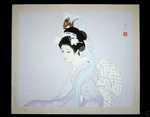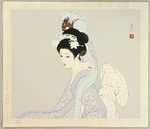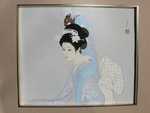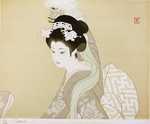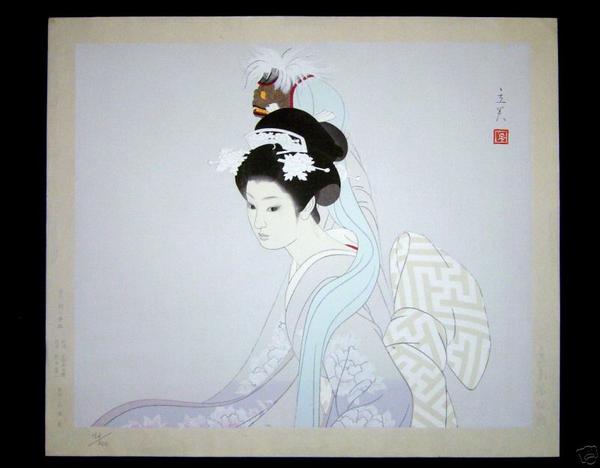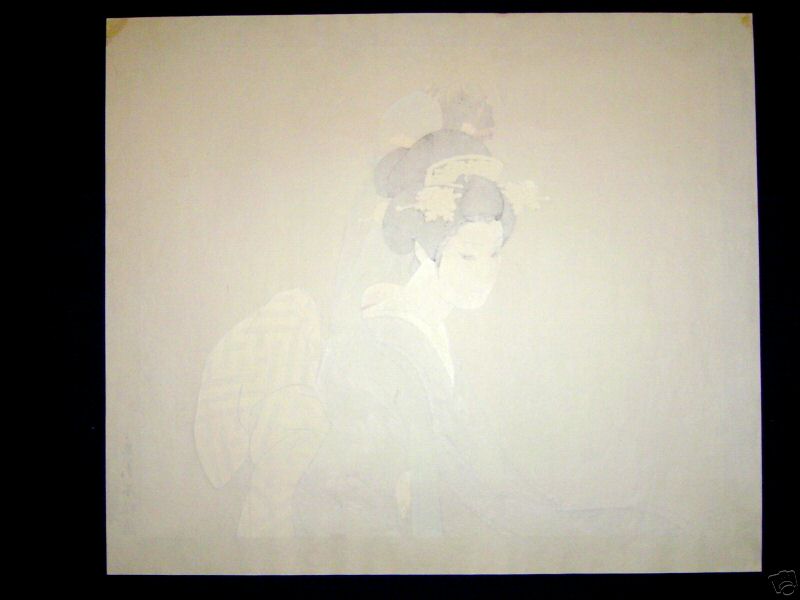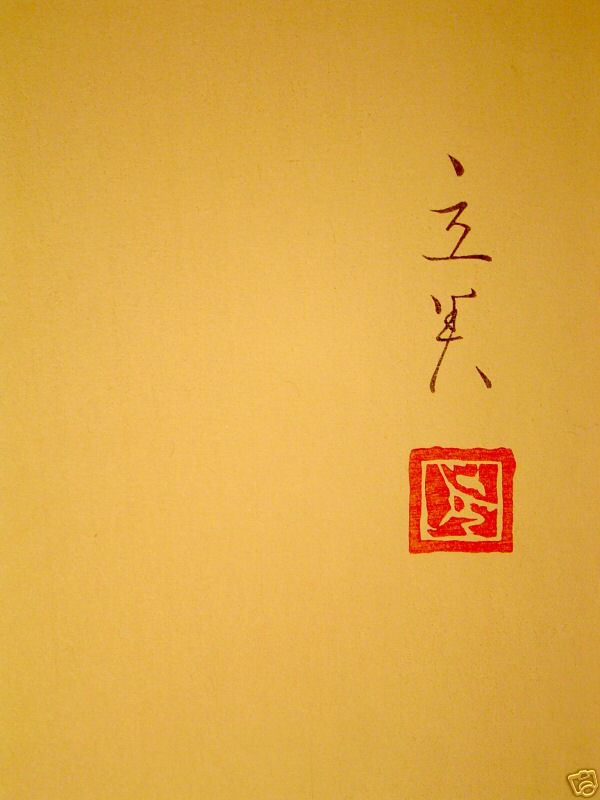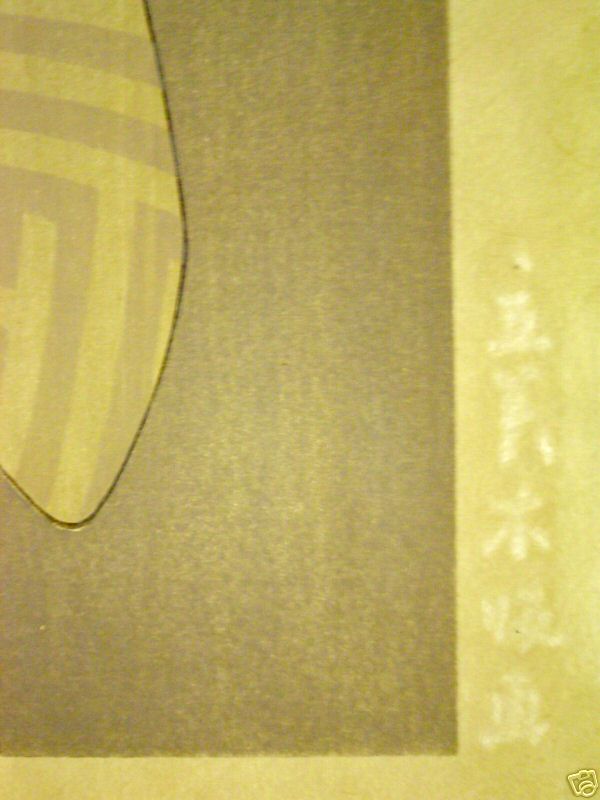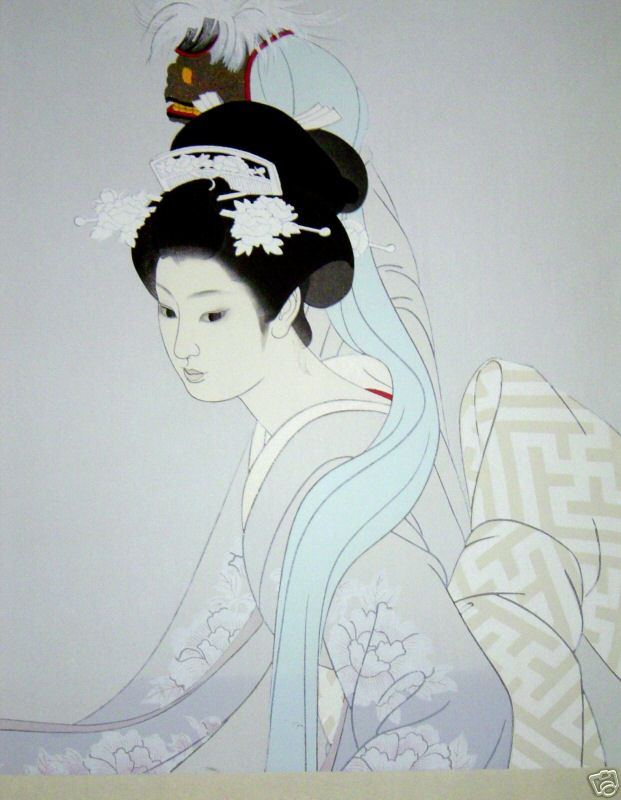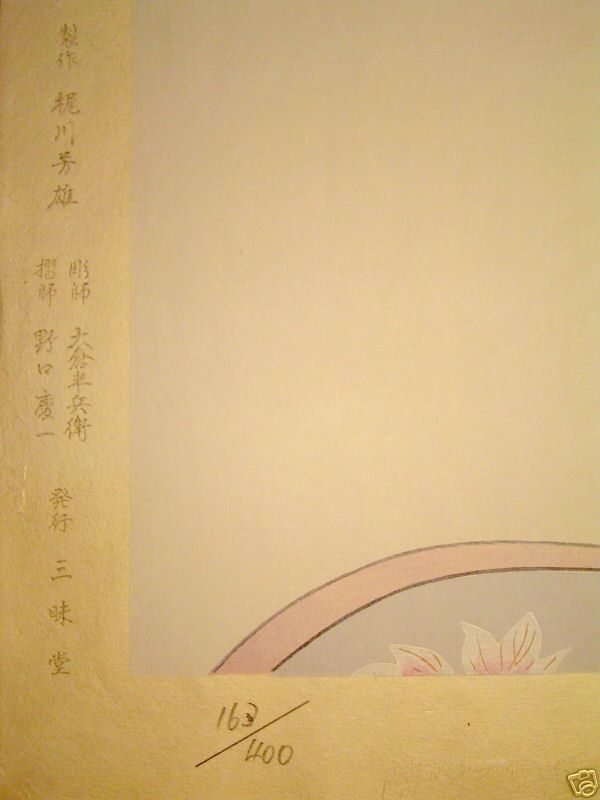| | |
| Artist: | Shimura Tatsumi (1907-1980) — 志村立美 |
| Title: | The Lion Dance (Kagami-Jishi) — 鏡獅子 |
| Series: | |
| Date of first edition?: | 1970 (in the decade of) |
| Publisher (first edition)?: | Sanmido — 三味堂 |
| Publisher (this edition)?: | Sanmido — 三味堂 |
| Medium (first edition): | Woodblock |
| Medium (this edition): | Woodblock |
| Format (first edition): | Double Oban
|
| Format (this edition): | Double Oban |
| DB artwork code: | 38803 |
| Notes (first edition)?: |
There are at least four editions of this gorgeous scene, one an edition of 300, another of 400, and a third of 420, plus a lithographic edition of 200. Rare.
"Kagami Jishi" is a fantasy whose story is related through the movements of the dancers. Yayoi, a young lady in waiting in the Shôgun's palace at Edo, was chosen to perform the lion dance at the New Year celebrations, a ceremonial performance originally designed to exorcize evil spirits. The dancer held a wooden lion head with moveable jaws which was decorated with a flowing silk streamer. Yayoi was shy and hesitant, so she was locked into a room with the mask and told to practice. At first she was overwhelmed by her surroundings and danced rather timidly. As she became more engrossed in the task her steps quickened. Fascinated against her will, she took up the lion head and danced a tentative movement. Gradually the spirit of the lion entered into her and took complete charge of her limbs. Two butterflies appeared and the lion head pursued them. Finally the dancing maiden disappeared altogether, leaving only the rampaging spirit of a lion, who then rushed into his lair and back again to sport among the peonies, where he finally fell asleep. Two butterflies appeared to tease him, and he tried angrily to catch them. Finally he worked himself into a mighty rage and stood shaking his great mane around in a fury of movement. |
|
| Notes (this edition)?: |
| The following information was taken from the original web listing of this artwork. Note that there may be some inaccuracies:
Monday, 2 January 2006
You are bidding on a very rare original Japanese woodblock print "Silent Lion" signed by the famous Showa Shin-Hanga artist Shimura Tatsumi (1907-1980) with PENCIL SIGNED NUMBER 163/400. Shimura Tatsumi was mainly a traditional Japanese painter so he did not create a lot of bijin ga prints before he died in 1980. The designs of his woodblock prints have an individual style and are something special - and beautiful. Because of these reasons, his Bijin ga woodblock prints are hard to find and are highly priced in Japan and Europe. Information on Shimura Tatsumi and his woodblock print can be easily found on any search engine. His woodblock prints are hard to find and sell for thousands dollars in the galleries. The size of this woodblock print is 20 x 17 1/4 inches. The colors, which are vivid and vibrant, are in layers. This woodblock print is not attached any backing paper or cardboard. Ink bleeding can be seen through the back of the original Japanese mulberry Washi paper. All four borders are intact. The artist’s signature and his chop mark are in the upper right corner of this print. In the lower left part of the bottom border of this woodblock print, there is number 163/400 written in PENCIL, which means this print is the 163th out of 400 prints. The inspector, carver and printer’s seals and publisher’s seal are in the lower left border. In the lower right border, is a watermarks saying "Tatsumi’s Mokuhanga" which roughly translates to "Tatsumi’s woodblock print". Usually, publishers only put watermarks on very expensive and special Japanese woodblock prints. This print was backed at the very outer edges and was in a picture frame for decades. Except for some very minor paper fringes along the very outer edges due to tape peeling, which does not affect the images at all, this woodblock print is in excellent condition.
|
|
| Artist Bio: |
Tatsumi Shimura is known for designing several striking bijin-ga prints towards the end of the Shin Hanga movement. Born in Takasaki, Gunma, Shimura's real name was Sentaro. In 1921, he began studying art with Yamakawa Saiho, a well-known illustrator. Three years later, he became an apprentice of Saiho's son, Yamakawa Shuho, who was also a bijin-ga artist. Shimura exhibited paintings with Kyodotai in 1927 and with Seikinkai in 1938. He became known for his paintings of beautiful women with long eyelashes and blurred pupils. As a young man, Tatsumi also worked as an illustrator for newspapers, serialized novels, and magazines, notably for the Japanese magazine "Woman's world" (Fujokai). His most famous illustrations were for the novel Tange Sazen by Hayashi Fubo. From 1948 to 1952, Shimura designed several woodblock prints of beauties that were published by Kato Junji. Later he collaborated with the Japanese Institute of Prints (Nihon Hanga Kenkyusho) to create a series called "Five figures of modern beauties" (Gendai bijin fuzoku gotai). These prints were first published in 1953 in an edition size of 200 and contain a thin red rectangular Gihachiro supervisor seal (Okuyama Gihachiro was the founder of the publisher). The series was later reprinted using recarved blocks in the 1960s/70s/80s in other edition sizes of 100, 200, and 300, plus an open (unlimited) edition (see here for further details). They depict Japanese women in traditionally feminine poses and attire. The finely detailed figures are juxtaposed against very simple backgrounds. Tatsumi later published various other gorgeous bijin-ga in double-oban size via the publisher Momose in the 1980s.
志村立美(しむら たつみ、1907年2月17日 - 1980年5月4日)は、日本画家、挿絵画家・ 美人画家である。群馬県高崎市生まれ。本名 仙太郎。群馬県高崎市生まれ。 神奈川県立神奈川工業高等学校図案科を中退して、1924年(大正13年)山川秀峰に入門美人画を修める。 当時、山川秀峰は鏑木清方と伊藤深 水と共に、挿絵での活動もしていた。 山川秀峰の推薦を受け、立美も挿絵での活動を行うようになる。肉筆画も鏑木清方主宰の郷土会、師である山川秀峰、伊東深水らの主宰する青衿会等へ出品をする。 その後主婦の友・婦女 界などの雑誌口絵などでその名を知られるようになり、林不忘原作の丹下左膳の挿絵などで岩田専太郎と並ぶ人気画家となる。晩年、挿絵での活動を休止し、本来の立美の原点である日本画、美人画への回帰をしていく。 出版美術家連 盟会長などをつとめ、1976年(昭和51年)作品集『美人百態』で日本作家クラブ賞を受賞する。「現代女性十二態 花吹雪」 木版 東京国立近代美術館所蔵 |
|



